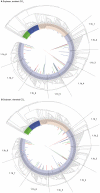Response of archaeal communities in the rhizosphere of maize and soybean to elevated atmospheric CO2 concentrations
- PMID: 21209969
- PMCID: PMC3012111
- DOI: 10.1371/journal.pone.0015897
Response of archaeal communities in the rhizosphere of maize and soybean to elevated atmospheric CO2 concentrations
Abstract
Background: Archaea are important to the carbon and nitrogen cycles, but it remains uncertain how rising atmospheric carbon dioxide concentrations ([CO(2)]) will influence the structure and function of soil archaeal communities.
Methodology/principal findings: We measured abundances of archaeal and bacterial 16S rRNA and amoA genes, phylogenies of archaeal 16S rRNA and amoA genes, concentrations of KCl-extractable soil ammonium and nitrite, and potential ammonia oxidation rates in rhizosphere soil samples from maize and soybean exposed to ambient (∼385 ppm) and elevated (550 ppm) [CO(2)] in a replicated and field-based study. There was no influence of elevated [CO(2)] on copy numbers of archaeal or bacterial 16S rRNA or amoA genes, archaeal community composition, KCl-extractable soil ammonium or nitrite, or potential ammonia oxidation rates for samples from maize, a model C(4) plant. Phylogenetic evidence indicated decreased relative abundance of crenarchaeal sequences in the rhizosphere of soybean, a model leguminous-C(3) plant, at elevated [CO(2)], whereas quantitative PCR data indicated no changes in the absolute abundance of archaea. There were no changes in potential ammonia oxidation rates at elevated [CO(2)] for soybean. Ammonia oxidation rates were lower in the rhizosphere of maize than soybean, likely because of lower soil pH and/or abundance of archaea. KCl-extractable ammonium and nitrite concentrations were lower at elevated than ambient [CO(2)] for soybean.
Conclusion: Plant-driven shifts in soil biogeochemical processes in response to elevated [CO(2)] affected archaeal community composition, but not copy numbers of archaeal genes, in the rhizosphere of soybean. The lack of a treatment effect for maize is consistent with the fact that the photosynthesis and productivity of maize are not stimulated by elevated [CO(2)] in the absence of drought.
Conflict of interest statement
Figures





References
-
- Drigo B, Kowalchuk GA, van Veen JA. Climate change goes underground: effects of elevated atmospheric CO2 on microbial community structure and activities in the rhizosphere. Biology and Fertility of Soils. 2008;44:667–679.
-
- Jossi M, Fromin N, Tarnawski S, Kohler F, Gillet F, et al. How elevated pCO2 modifies total and metabolically active bacterial communities in the rhizosphere of two perennial grasses grown under field conditions. Fems Microbiology Ecology. 2006;55:339–350. - PubMed
-
- Janus LR, Angeloni NL, McCormack J, Rier ST, Tuchman NC, et al. Elevated atmospheric CO2 alters soil microbial communities associated with trembling aspen (Populus tremuloides) roots. Microbial Ecology. 2005;50:102–109. - PubMed
-
- Drigo B, Van Veen JA, Kowalchuk GA. Specific rhizosphere bacterial and fungal groups respond differently to elevated atmospheric CO2. ISME Journal. 2009;3:1204–1217. - PubMed
-
- Austin EE, Castro HF, Sides KE, Schadt CW, Classen AT. Assessment of 10 years of CO2 fumigation on soil microbial communities and function in a sweetgum plantation. Soil Biology & Biochemistry. 2009;41:514–520.
Publication types
MeSH terms
Substances
LinkOut - more resources
Full Text Sources
Miscellaneous

